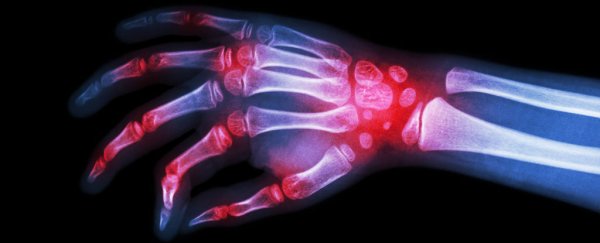When humans began their slow migration out of Africa some 100,000 years ago, they carried with them the genetic seeds necessary to help survive the bitter chill of Europe and Asia.
But, unknowingly, in the same genes lurked a painful burden that afflicts millions today – with a new study finding that a gene variant that helped our ancestors survive extreme climates and frostbite also increases the likelihood of developing arthritis.
According to researchers at Stanford and Harvard universities, a variant of the GDF5 gene – which is associated with bone growth and joint formation – has two effects on those that carry mutations of the gene: it reduces bone length (and, subsequently, height), and it can almost double the chance of osteoarthritis.
"It's clear that the genetic machinery around a gene can have a dramatic impact on how it works," says one of the researchers, human evolutionary biologist Terence Capellini, now at Harvard University.
"The variant that decreases height is lowering the activity of GDF5 in the growth plates of the bone. Interestingly, the region that harbours this variant is closely linked to other mutations that affect GDF5 activity in the joints, increasing the risk of osteoarthritis in the knee and hip."
In the new study, the team identified a previously unknown region of DNA surrounding the GDF5 gene. Within this region – called GROW1 – the researchers found a nucleotide change that is prevalent in Europeans and Asians, but which rarely occurs in Africans.
The thinking goes that this genetic change – which is found in half of Europeans and Asians – was favoured when modern humans made the trek out of Africa between 50,000 and 100,000 years ago, conferring some kind of physiological benefit to the migrants on the trail.
"Because it's been positively selected, this gene variant is present in billions of people," says developmental biologist David Kingsley from Stanford University.
"So even though it only increases each person's risk by less than twofold, it's likely responsible for millions of cases of arthritis around the globe."
But how would a gene variant that reduces bone growth help our long-ago predecessors survive in colder climates anyway, especially since it's served with a side order of boosting arthritis prospects?
The hypothesis is that a more compact body structure with shorter bones may have helped curb the risk of breaking bones and incurring serious injury – and that the benefits conferred from this stoutness outweighed the pain and inconvenience of sore joints.
"It's possible that climbing around in cold environments was enough of a risk factor to select for a protective variant even if it brought along an [increased] likelihood of an age-related disease like arthritis, which typically doesn't develop until late in life," Kingsley explains.
In addition to lowering the risk of broken limbs, it's also possible the reduced growth made it easier to withstand other dangers that come with colder weather, thanks to less exposed skin and extremities.
"Limb proportions in many endothermic animals follow a classic geographic pattern called Allen's rule, in which species at higher, colder latitudes evolve shorter distal appendages than do closely related species at lower, warmer latitudes," the authors explain in their paper.
"Shorter appendages conserve body heat and lessen the risk of frostbite in extremities in colder environments."
While the authors acknowledge that their hypothesis about why our ancestors favoured the GDF5 variant is speculative, there's clearly something going on here, because this genetic adaption didn't only happen once.
The migration out of Africa that took place between 50,000 and 100,000 years ago wasn't the first such journey. In earlier times, Neanderthals and Denisovans also made the migration, and an analysis of the DNA of these ancient forebears also indicated the GROW1 variant, suggesting humans have repeatedly favoured the mutation.
So, while many of us may in our lifetimes experience the pains and discomfort that come with osteoarthritis, perhaps in a small way we should be grateful.
After all, it's the legacy of an ancient and perhaps crucial survival trait – and one, without which, some of us might not be here at all.
The findings are reported in Nature Genetics.
